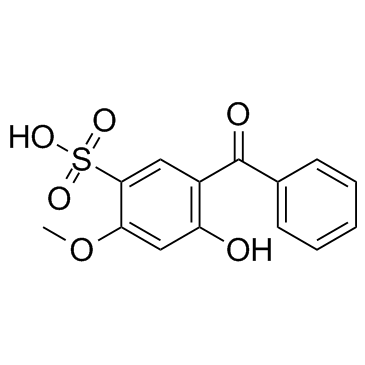Sulisobenzone

Sulisobenzone structure
|
Common Name | Sulisobenzone | ||
|---|---|---|---|---|
| CAS Number | 4065-45-6 | Molecular Weight | 308.306 | |
| Density | 1.4±0.1 g/cm3 | Boiling Point | 0°C | |
| Molecular Formula | C14H12O6S | Melting Point | 170 °C | |
| MSDS | Chinese USA | Flash Point | 0°C | |
| Symbol |

GHS07 |
Signal Word | Warning | |
|
Altered UV absorbance and cytotoxicity of chlorinated sunscreen agents.
Cutan. Ocul. Toxicol. 31(4) , 273-9, (2012) Sunscreens are widely utilized due to the adverse effects of ultraviolet (UV) radiation on human health. The safety of their active ingredients as well as that of any modified versions generated during use is thus of concern. Chlorine is used as a chemical di... |
|
|
iPSC-derived neurons from GBA1-associated Parkinson's disease patients show autophagic defects and impaired calcium homeostasis.
Nat. Commun. 5 , 4028, (2014) Mutations in the acid β-glucocerebrosidase (GBA1) gene, responsible for the lysosomal storage disorder Gaucher's disease (GD), are the strongest genetic risk factor for Parkinson's disease (PD) known to date. Here we generate induced pluripotent stem cells fr... |
|
|
Transcriptional expression of myelin basic protein in oligodendrocytes depends on functional syntaxin 4: a potential correlation with autocrine signaling.
Mol. Cell. Biol. 35(4) , 675-87, (2015) Myelination of axons by oligodendrocytes is essential for saltatory nerve conduction. To form myelin membranes, a coordinated synthesis and subsequent polarized transport of myelin components are necessary. Here, we show that as part of the mechanism to estab... |
|
|
The response of porcine monocyte derived macrophages and dendritic cells to Salmonella Typhimurium and lipopolysaccharide.
BMC Vet. Res. 10 , 244, (2014) Following infection and initial multiplication in the gut lumen, Salmonella Typhimurium crosses the intestinal epithelial barrier and comes into contact with cells of the host immune system. Mononuclear phagocytes which comprise macrophages and dendritic cell... |
|
|
Emerging pollutants in sewage, surface and drinking water in Galicia (NW Spain).
Chemosphere 86(10) , 1040-9, (2012) A monitoring programme was carried out on wastewater, surface and drinking water on the NW area of Spain during the four seasons of a year period (November 2007-September 2008). This study covered a series of emerging pollutants of different classes, includin... |
|
|
Sunscreens block the induction of epidermal ornithine decarboxylase by ultraviolet-B radiation: a new way of evaluating sunscreen efficacy in vivo.
Br. J. Dermatol. 107(2) , 215-20, (1982) Two proprietary sunscreen preparations containing para-aminobenzoic acid and sulisobenzone, respectively, were tested for their ability to block the induction of ornithine decarboxylase by medium wavelength ultraviolet radiation (UV-B) in the epidermis of the... |
|
|
Use of dermal equivalent and skin equivalent models for identifying phototoxic compounds in vitro.
Photodermatol. Photoimmunol. Photomed. 13(1-2) , 27-36, (1997) Phototoxicity inducing in vivo photoirritation, a reversible inflammatory reaction of the skin after chemical contact and UVA radiation exposure, is increasingly observed as a side effect associated with the use of both cosmetics and systemic drugs. In order ... |
|
|
Quantitative in vitro assessment of phototoxicity using a human skin model, Skin2.
Photodermatol. Photoimmunol. Photomed. 10(3) , 111-7, (1994) The ability to accurately predict the phototoxic potential of personal and skin care products remains a key element in assessing the safety of premarketed products. To find a reliable in vitro alternative test for photoirritancy, the European Commission and t... |
|
|
A reversed-phase ion-interaction chromatographic method for in-vitro estimation of the percutaneous absorption of water-soluble UV filters.
Anal. Bioanal. Chem 391(3) , 859-66, (2008) An analytical method based on ion-interaction chromatography with UV detection for simultaneous in-vitro estimation of the percutaneous absorption of the most used water-soluble UV filters in sunscreen cosmetics is proposed. These UV filters were phenylbenzim... |
|
|
Allergic contact dermatitis caused by benzophenone-4 in a printer.
Contact Dermatitis 64(3) , 183-4, (2011)
|